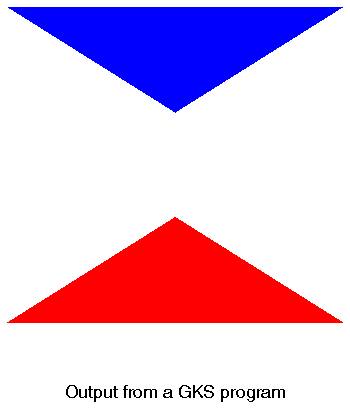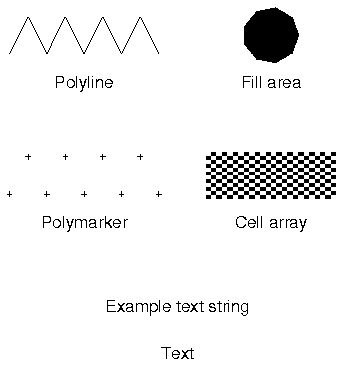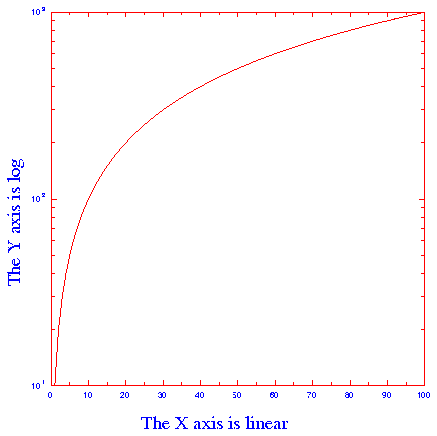GKS (the Graphical Kernel System) is an
ANSI
and
ISO
standard.
GKS standardizes two-dimensional graphics functionality at a
relatively low level. The primary purposes of the
standard are:
- To provide for portability of graphics application programs.
- To aid in the understanding of graphics methods by application
programmers.
- To provide guidelines for manufacturers in describing useful graphics
capabilities.
The GKS Standard (as described in the actual standard document:
Computer Graphics - Graphical Kernel
System (GKS) Functional Description, ANSI X3.124-1985) consists of
three basic parts:
- An informal exposition of the contents of the standard which includes
such things as how text is positioned, how polygonal areas are to be
filled, and so forth.
- A formalization of the expository material in 1. by way of
abstracting the ideas into discrete functional descriptions.
These functional descriptions contain such information as descriptions
of input and output parameters, precise descriptions of the effect each
function should have, references into the expository material in 1.,
and a description of error conditions. The functional descriptions in
this section are language independent.
- Language bindings.
These bindings are an implementation of the
abstract functions described in 2. in a specific computer language
such as Fortran or Ada or C.
GKS stratifies its functionality into twelve
functional levels,
depending
on the complexity of the graphical input and output. There are four levels
of output (m, 0, 1, 2) and three levels of input (A, B, C). NCAR GKS
contains a full implementation of the GKS Fortran and C bindings at level 0A.
Figure 1
- A plot generated with a GKS program
 NCAR Graphics is designed to facilitate organizing large amounts of
numerical data and producing concise visual representations of those data.
With the release of
Version 4.0 of NCAR Graphics
there are
three programming interfaces to the NCAR Graphics package:
NCL (
NCAR Command Language);
Fortran; and C. The programming interfaces provide
access to complex graphics utilities like contouring, world map projections,
and velocity vectors. For the most part, the C interface is built on top
of the Fortran interface.
NCAR Graphics is designed to facilitate organizing large amounts of
numerical data and producing concise visual representations of those data.
With the release of
Version 4.0 of NCAR Graphics
there are
three programming interfaces to the NCAR Graphics package:
NCL (
NCAR Command Language);
Fortran; and C. The programming interfaces provide
access to complex graphics utilities like contouring, world map projections,
and velocity vectors. For the most part, the C interface is built on top
of the Fortran interface.
The complex utilities of the NCAR Graphics package sit on
top of GKS-0A. This level of GKS affords more than the minimum level
(level m) of output functions, but allows for no graphical input; it cannot,
for example, be used to read a point off your screen, but you can output
almost any 2D picture to your screen.
The NCAR Graphics
Low Level Utilities (LLUs)
can use the NCAR GKS package that
is distributed with the package, or any other GKS package at level
0A or higher. It is possible to use NCAR Graphics
without having but a brief knowledge of GKS. However, if
you intend to use features of GKS directly, you will need to know
more about GKS. In NCAR Graphics version 4.0 and later, direct
GKS calls are viewed as
LLU calls. For details on mixing LLUs with
the HLUs, see the module
Mixing HLUs and LLUs.
For a discussion of the pros and cons of using LLUs versus the
High Level Utilities (HLUs),
consult the module
HLUs vs. LLUs.
The NCAR GKS documentation modules (of which you are currently reading
the "Introduction" module) are all accessible from the "
GKS Home Page
" module.
The NCAR GKS documentation modules contain some site-specific details
of NCAR's implementation of GKS-0A. The modules
are meant to be used in conjunction with the
other on-line documentation
for NCAR Graphics.
For the purposes of explication, as well as for
historical reasons, the NCAR GKS documentation modules focus most heavily
on the
Fortran binding,
although complete details on the
C binding
are presented.
Described in the NCAR GKS documentation modules
are the most commonly used GKS functions of the NCAR
Graphics package. GKS at level 0A contains 117 standardized Fortran user
entry points and only about half of those are described. If you
would like a full understanding of the GKS standard, or more thorough
discussions, you should consult the references in
Appendix E.
All of the
references cited are available in the NCAR book
libraries.
GKS at level 0A standardizes a reasonably complete set of functions for
displaying 2D images. Users of pre-GKS
versions of NCAR Graphics will
recognize GKS at level 0A as being a functional extension of what was
called the NCAR System Plot Package (
NSPP
), although with a significantly
different user interface. (NSPP contained lower-level graphics calls and
was written at NCAR. It did not adhere to any graphics standard and was
replaced with GKS in the mid 1980s.) At level 0A, GKS contains functions
for drawing lines, markers, filled areas, text, and a function for
representing rasterlike images in a device-independent manner. In addition
to these basic functions, GKS contains many functions for changing the
appearance of the output primitives, such as changing colors, changing
line thicknesses, changing marker types and sizes, etc. The functions for
changing the appearance of the fundamental drawing functions (output
primitives) are called attribute setting functions.
Here is a brief description of the output primitives and their attribute
functions. A utility function (that is not part of the GKS Standard) that
can be used to save, restore, or set
all attribute values in a single call is described in the documentation
for NGSRAT.
Detailed descriptions of these functions appear in the
Output Primitives module.
The GKS function for drawing line segments is called polyline. The polyline
function takes an array of X-Y coordinates and draws line segments connecting
them. The attributes that control the appearance of a polyline are:
- Linetype, which controls whether the polyline is drawn as a solid,
dashed, dotted, or dash-dotted line.
- Linewidth scale factor, which controls how thick the line is.
- Polyline color index, which controls what color the line is.
The GKS polymarker function allows you to draw marker symbols centered at
coordinate points that you specify. The attributes that control the
appearance of polymarkers are:
- Marker, which specifies one of five standardized symmetric characters
to be used for the marker. The five characters are dot, plus,
asterisk, circle, and cross.
- Marker size scale factor, which controls how large each marker is (except
for the dot marker).
- Polymarker color index, which specifies what color the marker is.
The GKS text function allows you to draw a text string at a specified
coordinate position. The attributes that control the appearance of text are:
- Text font and precision, which specifies what text font should be
used for the characters and how precisely their representation should
adhere to the settings of the other text attributes.
- Character expansion factor, which controls the height-to-width ratio
of each plotted character.
- Character spacing, which specifies how much additional white space
should be inserted between characters in a string.
- Text color index, which specifies what color the text string should be.
- Character height, which specifies how large the characters should be.
- Character up vector, which specifies at what angle the text should be
drawn.
- Text path, which specifies in what direction the text should be written
(right, left, up, or down).
- Text alignment, which specifies vertical and horizontal centering
options for the text string.
The GKS fill area function allows you to specify a
polygonal shape of an
area to be filled with various interior styles. The attributes that
control the appearance of fill areas are:
- Fill area interior style, which specifies how the polygonal area
should be filled: with solid colors or various hatch patterns, or
with nothing, that is, a line is drawn to connect the points of the
polygon, so you get only a border.
- Fill area style index. If the fill area style is hatch, this index
specifies which hatch pattern is to be used: horizontal lines; vertical
lines; left slant lines; right slant lines; horizontal and vertical lines;
or left slant and right slant lines.
- Fill area color index, which specifies the color of the fill patterns or
solid areas.
The GKS cell array function displays rasterlike images in a device-independent
manner. The cell array function takes the two corner points of a rectangle
that you specify, a number of divisions (M) in the X direction and a number
of divisions (N) in the Y direction. It then partitions the rectangle into
M x N subrectangles called cells. You assign each cell a color and create the
final cell array by coloring each individual cell with its assigned color.
At level 0A, cell array has no associated attributes.
Figure 2
- example illustrating the GKS output primitives.

GKS provides a set of inquiry functions that return the current values of
GKS variables. Included are variables related to GKS operating states,
workstation status, transformations, output attributes, and others.
For example, you can inquire about the current value of any GKS output
attribute such as the fill area style index, polyline color, polymarker
type, and so forth.
Inquiry functions are useful when it is desired to isolate a code so that
it can work independently from attribute settings elsewhere. In this case,
you can inquire about the value of a variable, save this value, set the
value to what the immediate code requires, then reset it to the original
value before exiting. In this way, one module will not change the values
of variables which are assumed by another module.
Figure 3
- results of code using inquiry functions to isolate drawing text.
 Calls to non-inquiry GKS functions can generate errors. When an error
is encountered in such a non-inquiry function, GKS enters an error state,
an error handler is called to print the error message, GKS exits the
error state, and control is passed back to the calling program. The error
handler can be replaced by a user-supplied function, but that is an
advanced topic that will not be discussed in the GKS documentation
modules. For details on the error handler,
consult one of the references in
Appendix E.
Calls to non-inquiry GKS functions can generate errors. When an error
is encountered in such a non-inquiry function, GKS enters an error state,
an error handler is called to print the error message, GKS exits the
error state, and control is passed back to the calling program. The error
handler can be replaced by a user-supplied function, but that is an
advanced topic that will not be discussed in the GKS documentation
modules. For details on the error handler,
consult one of the references in
Appendix E.
The inquiry functions of GKS are designed in such a way that the inquiry
call will not itself generate an error condition, that is to say GKS never
enters an error state and nothing is printed. If the parameter
values requested are not available (they do not exist for some reason), an
output error indicator is passed back in one of the arguments of the
inquiry function. This error parameter indicates whether or not the returned
values are valid. If all values are available, the error indicator value is
zero. If all state variable values are not available, the error indicator
returns an error number which identifies the GKS error condition. These
numbers are the same as those used for non-inquiry functions.
An error message list appears in
Appendix D.
Links:
GKS Index,
GKS Home


